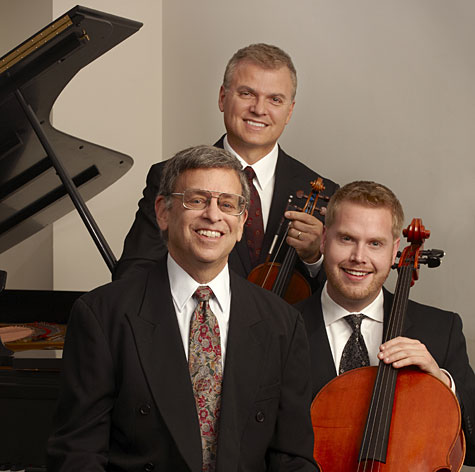
Maurice Ravel’s Trio in A minor is among the most technically difficult works in the piano trio repertoire, demanding virtuosity on the part of all three players. Ludwig van Beethoven’s Trio in B-flat major, opus 97 — the “Archduke Trio” — widely is acknowledged as a masterpiece of the form.
At 7:30 p.m. Sunday, Jan 22, Washington University’s Eliot Trio will present both works, along with Alexander Zemlinsky Trio in D minor, opus 3, for an intimate concert in Holmes Lounge.
Tickets are $25, or $15 for seniors and Washington University faculty and staff, and $5 for students. Holmes Lounge is located in Ridgley Hall, on the west side of Brookings Quadrangle. Tickets are available through the Edison Theatre Box Office, (314) 935-6543, and all Metrotix outlets.
For more information, call (314) 935-5566 or email daniels@wustl.edu.
Program
Named for university founder William Greenleaf Eliot, the Eliot Trio is dedicated to performing masterworks of the piano trio literature. It consists of Seth Carlin, professor of music and director of the piano program in the Department of Music in Arts & Sciences; violinist David Halen, concertmaster for the St. Louis Symphony; and cellist Bjorn Ranheim, also with the St. Louis Symphony.
The group typically presents one concert each year.
The Jan. 22 program will open with Zemlinsky’s Trio in D minor. Though today overshadowed by his lifelong friend, student and eventual brother-in-law Arnold Schoenberg, Zeminsky was a highly regarded composer and conductor in fin de siècle Vienna. This trio, completed in 1896, is indebted both musically and professionally to Johannes Brahms: The closing movement takes its main theme from Brahms’ trio of 1892, while Brahms himself arranged for the work’s publication in 1897.
Next on the program will be Ravel’s Trio in A minor. Completed in 1914, as the composer prepared to enlist in the French army, the piece encompasses a range of exotic influences and irregular metrical schemes, opening with a distinctive 3/2/3 rhythmic pattern drawn from Basque folk dances. The second and third movements refer respectively to Malaysian poetry and the Baroque passacaglia, building toward the dazzlingly orchestral fourth movement, in which passages alternate between 5/4 and 7/4 time signatures.
Following intermission, the program will conclude with Beethoven’s “Archduke Trio,” which the composer dedicated to his friend, former student and sometime patron Archduke Rudolph of Austria. Written in 1811, near the end of Beethoven’s “heroic” period, it is the last and arguably greatest of his complete piano trios, the four grand movements drawing equally on all three instruments to suggest symphonic scale.
Notably, in 1814, Beethoven himself performed the work’s public debut — his final appearance as a pianist.